Sink or Swim
The “new normal” has consumed our outlook over the past six months. Now that we are partially off the global economy treadmill of pre Covid, how do we position ourselves for an uncertain future? The answer is the perennial advice: do the basics
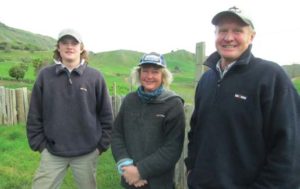
Jamie Sue and Jock Stratton
well, and look after your capital stock. During ram selling in November and March/April we heard many stories of Personal Best lambing percentages, a tribute to your management skills as well as to your genetics package! We have talked to many of you over the past three months, to find out how you have fared through drought, flood, and the sharp reduction in farm gate prices. We have heard numerous comments about how well Waireres have held up through difficult climatic conditions. Those who have coped best were proactive in selling early, took advantage of fixed price contracts through to April, and supplementary fed capital stock if required.
The early bird catches the worm
One example is Jock and Sue Stratton, who farm 562 hectares effective east of Taihape. They started feeding ewes and hoggets in late February, baleage with maize grain spread on top. They locked up a thousand ewe hoggets in a lane, and 2,500 ewes on a four hectare paddock. The ewes were fed for six weeks, the hoggets for five. Cows and calves were grazed next door from early January to mid April, and a few trade cattle for nine weeks. Feeding cost $100,000, but pasture covers bounced back to 350kgs DM over
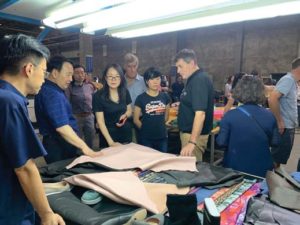
Michael Lu, second from left with the SFF group.
target level by mid May, and all capital stock have been retained. Not only that, but ewes tupped as body condition improved, and a scanning of 181% twin/ single has been achieved. Since autumn dry has become the new norm, Jock has used Ovastim to guarantee a high percentage. Gross farm revenue was $1520/hectare, and EFS still $525/hectare after the supplementary feed costs of $186/hectare. The pasture response to the normal NPS fertiliser (30kgs N) in autumn was so dramatic that 250 trade cattle were purchased in April at rock bottom prices. Jock: “We were confi dent that we could absorb the cash cost of feeding, because our stocking rate and performance levels are high. The Wairere Composites have lambed 153-158% over the past three years, and the hoggets 72-86%. Some years we sell 100% of our lambs prime, in others it could reduce to 20%. Selling lambs early this year worked out well. One thing that I’ve noticed about droughts: the farm gate price takes a long time to recover, but the following season is always rewarding for those farmers who have their normal numbers to sell. The message: take the hit in the drought year, so that you’re back on track for the next season.”
China wins, New Zealand loses
Sam and Sarah Von Dadelszen were part of a SFF supplier trip to China in May 2019. The group met a dynamic entrepreneur who’s business processes around sixty million lamb and sheep woolskins and pelts each year. Michael Lu started his career as a translator for Italian leather buyers. He soon realised that the Italians were poor negotiators, leaving fat margins for the processors. So he started the sheep skin processing company Hernan Prosper in 1994, and gradually expanded. He now has the largest global share of the wool on skin market, and a company worth $US2 billion with no debt. There are 12,000 employees, and fi fty containers of skins going daily into the factory. The business covers 160 hectares. Most employees live on site, are paid $600-1,000 per month, plus a further 35% of that cash payment in benefi ts such as accommodation. The factory works 24 hours per day, with three shifts, six days per week. Earlier Lu had been off ered a 30% share in Allbirds, but turned it down. He regretted that, but now manufactures a similar article. He showed the SFF group his 3D printing machines making shoes. There were lots of other value added products, including bags and leather clothing.
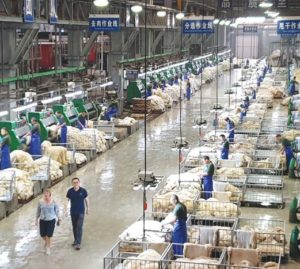
The factory covers 160 hectares.
He came to Christchurch and bought a skin processing company, as “it was too cheap not to buy!”(more control lost by NZ). In 2020 the company expanded into cattle hides, targeting by 2023 to be processing 4,000 hides per day for the automotive industry and high end furniture. The group stayed in Lu’s fi ve star hotel, on site, and were superbly catered for by his chefs. How does that work for NZ sheep farmers? There were years in the 1980s when lamb pelts were worth $12, as much as the carcass. Right now pelts are going to landfi ll. The same trend has happened with wool. The same will happen with logs, when China fulfi lls its ambition to expand processing capacity at several ports to become “the world’s premier wood processor”. New Zealand producers are on a hiding to nothing when we give up control of our products before the ultimate market. Meantime, our socialist government is naively obsessed with trying to combat climate change, and gradually increasing the tax on fuel to pay the rich investors in subsidised carbon credits. New Zealand will have less and less venture capital available to create value added businesses. New Zealand farmers do best when we send produce direct to retailers/consumers, e.g. Kiwi fruit, very little processing required.
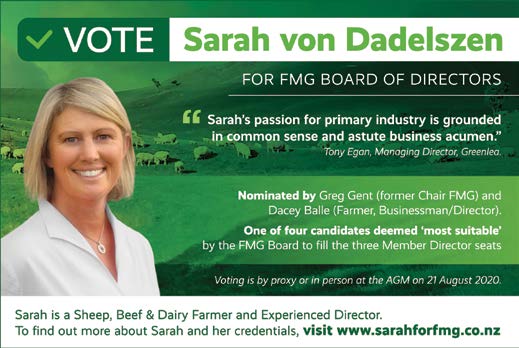 Have you voted?
Have you voted?
I endorse Sarah Von D. as an exceptional farmer/business person.
She has nineteen years experience as a director, and has recently
graduated from the International Director’s Programme of Insead.
Reinventing New Zealand?
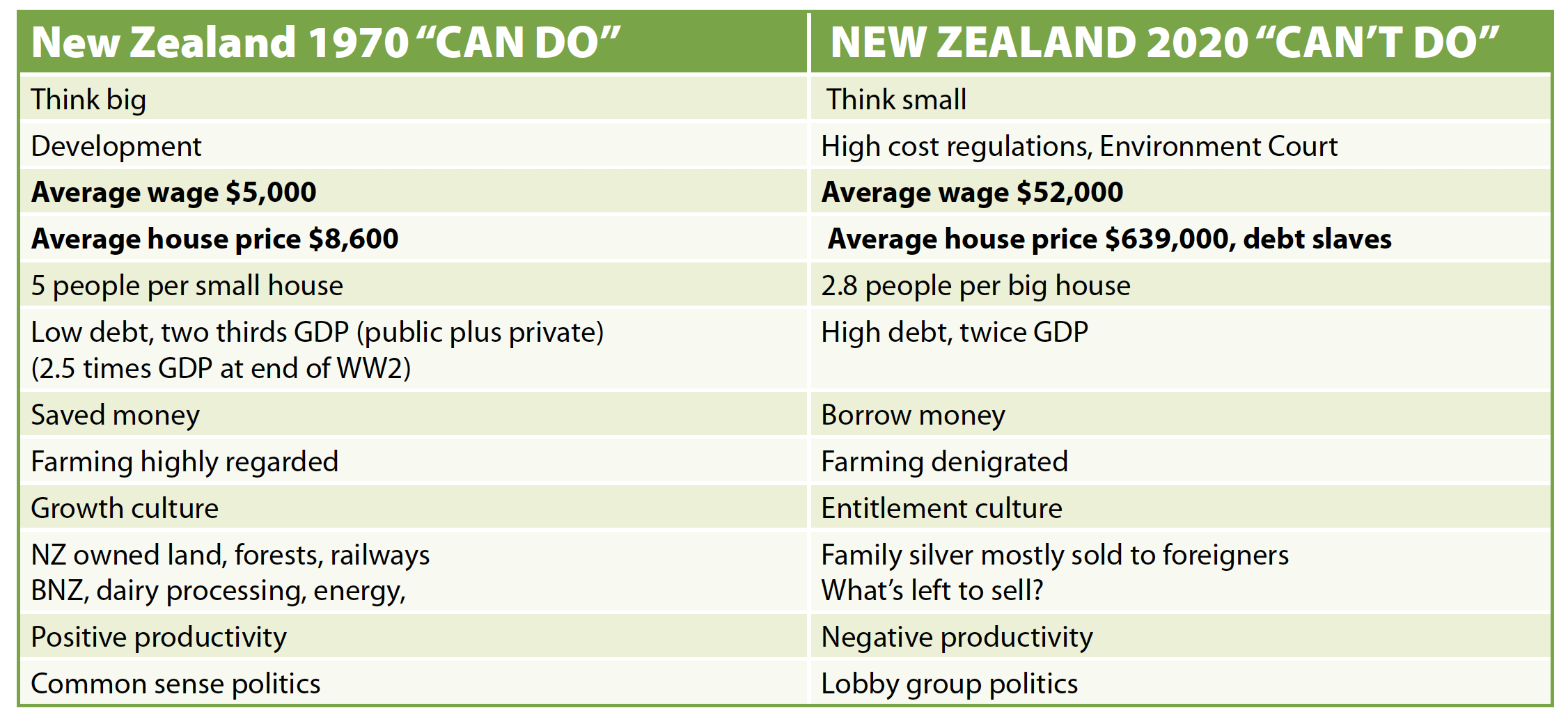
With the odd exception, New Zealand is now led by people who have never been hungry, never fought in a war, and never run a business. Will we have the discipline, as our forefathers did, to rebuild at an affordable cost?
Think think think!
Henry Ford: “Thinking is the hardest work there is. That’s why so few people do it.”
- Our biased media tend to give one side of a story. Here are some thoughts… l Sediment is “bad”, but civilisations have grown where sediment provides rich soils. Think of the Nile, or Canterbury plains, think of the great “bread bowls“ around the world, sediment left by glaciers, think of the rich volcanic soils at Pukekohe.
- Nutrient is “bad” in water, but biodiversity is enhanced with more nutrient. Think of the rivers and lakes in Africa, with three tonne hippos living in them, and 22 times the number of freshwater fish species than evolved in the low nutrient water of NZ rivers and lakes.
- Promoting the Maori tradition for guardianship of the land? During 5-600 years of settlement in New Zealand the Maori burnt around one third of the country’s native forest and made 32 species of bird extinct. The increasing population and dwindling food resource led to intertribal warfare, slavery and cannibalism. When missionaries arrived, Maori immediately saw the advantages of new crops and new tools. Current government policies are taking us down the same track… more and more people with less and less land in food production.
- The One Billion Trees program would be achieved for free by allowing wilding pines to spread across the Hieracium infested scree slopes of the South Island. Instead, the government plans to borrow $190m to control wilding pines, tax all citizens indirectly to pay a few rich people to smother good farm land with pine trees, and lose out on export income and food from that sheep and beef land for thirty years.
- The Minister of Agriculture turned down $5m to keep Taratahi Agriculture Training Centre going, while obtaining funding of $33m for Westland Polytechnic in his electorate, pork barrel politics. Has NZ ever had a Minister of Agriculture so anti farming? And this year, many polytechnics and DHBs are putting their hands up for “emergency funding”.
- “The Environment” has become a new religion. Lobby groups create anxiety to persuade people to fund their campaigns. GreenPeace’s most successful fundraising has been their campaign against GMOs. The first President of GreenPeace, an eminent scientist, resigned from the organisation because others would not consider the positive potential in GMOs.
- Another example, the campaign against using palm kernel: it makes economic sense to use a valuable feed supplement transported by ships returning empty from Asia to NZ, rather than let it rot in the jungle. The campaign against palm oil has had no impact, because it is such a valuable product, “used in half the items on supermarket shelves.”
- How have richer countries responded to the “climate change crisis”? Did Singapore promise to halve the number of flights through Changi? Did Norway promise to ban oil and gas exploration? No other country is damaging its economy like New Zealand is.
- The Paris Accord is a lost cause. With only 20% of the world’s GHG emissions involved, how will it “save the world?”
- Over 80% of NZ’s log exports go to China. Most of those logs are sawn into timber which is used for boxing around concrete. Once used, it is burnt. So much for storing carbon! And where would NZ logs go now, if China wasn’t building? And where will logs go in thirty years time, when the world population has stopped growing? Food can always be sold, but you can’t eat wood.
- Many people in the Netherlands starved at the end of WW2, so a law was passed to prevent rural sprawl via lifestyle blocks. But here in New Zealand we are rapidly squandering our best land under housing or pine trees, while our population increases at around two percent per year. And food production is our major export sector.
- A recent scientific paper (Nature Food, 17 June 2020) analysed how to achieve a least cost nutritious diet in the USA. The conclusion? The least cost plant based diet cost $US3.61 per day, whereas a meat and plant diet cost only $1.98 per day. “The prices of animal based foods had to be increased by 2-11.5 times to be excluded from the modelled food pattern.”
- New Zealand is losing out on up to $4billion in NET tourism, $2billion, increasing to $5billion, in educating foreigners, up to $1.5billion in decreasing oil and gas exports, $1.2billion in aluminium exports…Where is the Switzerland of the Southern Hemisphere?
- NZ is one of seven countries with the cleanest water in the world. What’s the prize for being better than that? If more swimming is a desired objective, why wouldn’t government pay for ten Olympic sized indoor pools in both Canterbury and Waikato, rather than dramatically change land use for dubious advantage? Or pay for a huge sewer pipeline to take Hamilton’s waste to Raglan?
- Doctors’ mistakes cause an estimated 20,000 deaths per month in the USA, which would equate to around 300 per month in NZ. Media should focus on doctors’ mistakes rather than farmers’ mistakes. It’s “life and death.”
- NZ politics has been captured by Green lobby groups. Treasury’s forecast in 2014 that NZ’s drive towards carbon neutrality would cost 16% of GDP has been conveniently forgotten. How can you be Green when you’re in the red? New Zealand is about to find out.
Cost of bulls versus rams
Bull sales have been buoyant this winter, with many sales averaging $10,000 per bull. Market research shows that bulls last 2.3 years, on average. If a bull mates 50 cows at 90% calving for 2.3 years, he aff ects the genes of 117 calves. If those bull/heifer calves are worth $1,000 each at weaning, the bull aff ects $117,000 of progeny, $87,750 if all the calves average $750, $70,200 if the mix of calves average $600. Deducting the residual value of the bull at $2,000, the bull at $8,000 infl uences 15 times his value when male and female weaners average $1,000 each, 11 times his cost when weaners average $750, and 9 times his cost when weaners average $600. If the average ram lasts 3.5 years, mates 100 ewes at 140% weaned, he aff ects the genes of 490 lambs. If those lambs are worth $120 at weaning, the ram infl uences $58,800; at $100 per lamb, $49,000; at $70 per lamb, $34,300. Deducting the residual value of a ram at $100, an average ram at $1,100 infl uences 53 times his cost when lambs average $120 at weaning, 44 times his value when lambs average $100, 31 times his cost when lambs average $70 at weaning. Conclusion: you can relax knowing that rams are 25 to 30 percent of the relative cost of a bull. Or, to put it another way, the average ram should sell at $4,000 to equate to the $10,000 bull.
WRIG 50th
John Daniell and Holmes Warren started the Wairarapa Romney Improvement Group in 1970. It is a credit to the founders that the Group still continues today, in some cases with the third generation involved. The Group organised a celebration in late July, with speakers and a dinner. Keynote speaker, geneticist Dorian Garrick, made a number of observations.
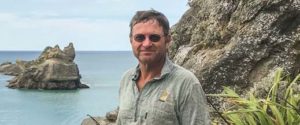
New Zealand’s pre eminent geneticist Dorian Garrick.
We can get to new places with performance recording, evaluation, selection. They work even better today, because we can collect a lot more with our electronic devices, we have much better statistical methods, we have genomic ways of checking parentage, etc. But we have to be focused on sensible breeding goals.”
Lamb Survival
Improved lamb survival and a thicker skin go together. Scott Farmer has been eye muscle scanning our Wairere Merino ram hoggets in Central Otago. He always comments on the much increased skin thickness compared to other Halfbreds that he scans.
Correction, Norman Hunter, Southland.
“You had my story in your January newsletter. I had my tailing tallies wrong. I missed one paddock, so tailed 154% rather than 149, discovered when I thought the shearers were infl ating their count of my lambs! It’s not often that tallies surprise on the upside! And that makes the lamb survival in a diffi cult spring even better than I had thought.”
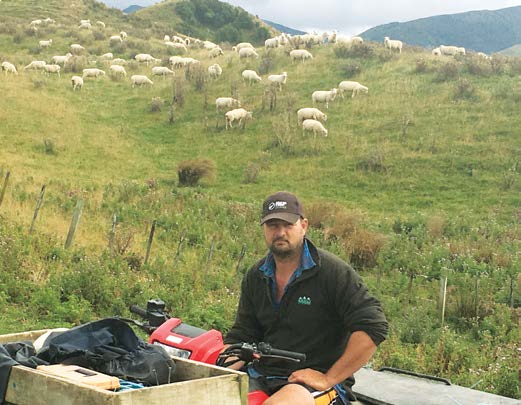
Daniel Udy, farming in a 2,400mm rainfall area near Eketahuna, docked 160% in 2019. Daniel and Bridgette had a Coopworth fl ock until 2006, lambing 130%-140%, but have enjoyed steady improvement in survival with Wairere Romneys.
Finishing versus breeding
“Breeder finishers” face an annual challenge in the conflict between these two aspects. The decisions start at weaning. Here are some observations:
- The most important stock class to “finish” are your ewe lambs. The cents per kgDM earned will always be higher than for sale lambs, and the return lasts that lamb’s lifetime in your flock. Ewe lambs come first in priority.
The cheapest finishing happens before weaning. Bigger lambs at weaning allow more to be sold prime. A high lamb weaning weight means a high ewe weaning weight. A ewe will carry that condition through the twelve month cycle of mating, lambing, weaning.
- The growth rate to weaning sets the upper potential for growth rate post weaning. l Early lambs usually make more money. Why carry a 15kg carcass weight lamb from early December to sell it for the same value at 18kg at the end of February?
- A reduction in lamb numbers reduces the exposure to the rise in internal parasite numbers in the danger months of March/April and later. l Some farmers are using specialist crops, some short term, some lasting years, to wean some ewes early, with 60 day old lambs able to continue growing fast. The ewes can then be killed on a high paying market.
- It is difficult to combine a breeding and finishing farm under the same ownership. Each enterprise needs to look after its own supply/demand of feed relative to classes of stock, and conflicts usually arise.
- Finishing farmers continually analyse the market for the best trades. Buying at the right price is a critical factor for optimising profitability, but that has to be matched with feed supply that can optimise growth rate.
- Breeding farmers have other priorities too: ensuring that hoggets which reared lambs are fed well to restore live weight and condition, and lifting the BCS of two tooths and light mixed age ewes after weaning.
- For reinforcement of these key messages, I can recommend the weekly AgLetter, available on email on Saturday mornings. Although the BakerAg consultancy is Wairarapa based, the AgLetter has subscribers nationwide, as do the BakerAg consultants. If you subscribe, you’ll have access to a library of 1,500 past publications with management advice, and you will be able to refer to a particular topic.
Client Success Stories
Long term clients, Lewis and Marisa Newton, northern Taranaki “I’ve just had my best farming year ever. With 2,050 Wairere Romney ewes and 650 hoggets I grossed $588,000 from the sheep in 2020. That’s $218 per sheep wintered from Taranaki hill country, near Urenui. I docked 3,900 lambs, with sale lambs averaging 18.3kgs, most gone by end of February. The cull hoggets killed out at 25kgs and $200. Cull ewes killed at big weights and averaged up to $218 for a line of wet drys.
Why the improvement? I’ve been applying a lot of lime in recent years, and the pH now averages 5.7, P levels 15. Scanning used to range from 170 to 179, including triplets. Now scanning is consistently around 190. Also, I run a high cattle ratio, 720 wintered on the 730 hectares. I calve late, November, and sell the weaner bulls and tailend heifers in the late winter, as the Hawke’s Bay market springs into life. My farm ranges from extremely steep to slumpy country, with 2,500mm rainfall. I used to farm 1,600 hectares, but a son and two sons in law now have three separate farms, part of the home block and land purchased next door.
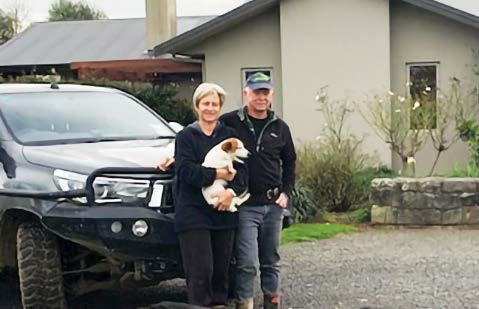
Lewis and Marisa Newton, northern Taranaki
Robert and Jane Brown, with sons, Nick Will and Sam, eastern Taranaki. The Brown family, on two properties, have swept the Ballance Farm Supreme Environmental Award for Taranaki in 2019. The home farm has achieved consistent productivity for many years. Robert started buying Wairere Romney rams in 1993. Since 2010 there has been a significant rise in facial eczema challenge. That prompted a change to Wairere Challenger rams. Lambing percentages took a dip, but are now consistently in the 140- 150 bracket.
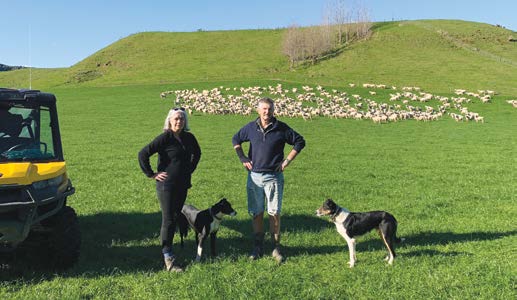
Robert and Jane Brown with lighter, twinning ewes drafted off at scanning onto new grass, which “has been fantastic all winter”.
Land is expensive in Taranaki, given the demand for dairy runoffs. The Brown family shore 8,000 sheep this year to help reduce costs. Robert had shorn professionally for fourteen years, and competed in the Open section of Golden Shears a number of times. Now he is content to get the gang off to a flying start, but then has more important things to do! There’s no doubt that this family team effort will succeed in establishing the next generation in profitable farming ventures.
Jim and Brendan Varty, North Wairarapa. “We sold our cows after a drought in 2015. But our sheep performance dipped. A couple of years ago I bought back into cows, and that has sharpened up flock productivity. In 2019 scanning was a relatively low 170%, but good survival resulted in153% lambs docked. And average weaning weight across all lambs was 32.6kgs in 90 days, 75% of ewe live weight of 66kgs at tupping.
We believe in reducing sale lamb numbers as fast as possible, with 1,960 sold at weaning in 2019. We have analysed the cost/benefi t of a summer crop for fi nishing lambs, but have decided that the KISS principle of grass only, is the better option. In January we select our ewe lamb replacements, then sell the second cut for breeding. This season, as the dry intensifi ed, we were out of all surplus lambs by early March. As a result we were able to keep reasonable condition on our two tooths, many of which had reared lambs as hoggets, and on our ewes. The two tooths scanned 172%, not counting triplets, at 62kgs, and the mixed age 173. All ewes have bounced back in BCS after rain started at the end of March. We haven’t had to use any supplement. It has been one of our two most profi table years since we bought the farm in 2005.”
Wairere’s film star
Since Wairere aired on Country Calendar, I’m often asked if Dayanne is still at Wairere. No, but in April 2019 Dayanne moved with partner Paul Crick to a large lease block southeast of Masterton, where they are running 7,800 stock units, including some deer. They are also running the hill country progeny test fl ock for Beef and Lamb Genetics. This is a continuation of Taratahi running the B+LNZ Genetics Sheep Progeny Test for the previous six years. ”Our commercial flock was a Rissington composite eight years ago, but has been bred to Wairere Romney since then, so hoggets and young ewes are 75 and 87% Wairere or more. Despite the drought this year, the ewe lambs still scanned 125%. The ewes last year weaned 160%, and have scanned 180%, including triplets, this winter.” Paul is currently chair of the Beef + Lamb Farmer Council executive. And Dayanne was head hunted by Zoetis in April 2019 to liaise with all North Island bull and ram breeders using genomics. Her success in that role has been rewarded by promotion to a Technical Lead role for Zoetis. Completion of her M.Ag.Sci masters thesis on Body Condition Score, plus a continuation of eleven years of hands on farming/ram breeding, and future completion of a PhD will give Dayanne a strong base to become a leading geneticist of her generation.
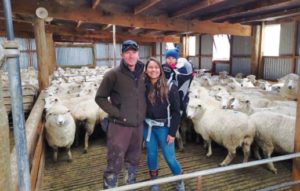
Paul and Dayanne with Daughter Isabella
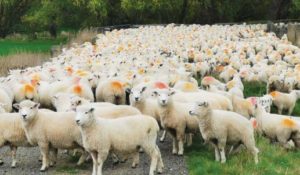
Paul and Dayanne’s ewe hoggets scanned 125% this year
So, Wairere has lost Dayanne in a full time capacity, but her Zoetis interaction with most ram breeders in the North Island has broadened her knowledge as a practical genetics advisor. At Wairere we applaud Dayanne’s progress as a genetics advisor, and are fortunate to be able to call on her advice at any time.

Andrew and Lynn with Wairere two tooths, late July 2020
Welcome to our new South Island sales manager Andrew Herriott
Andrew will take on the role of Wairere South Island Sales Manager from early August. Andrew and Lynn set up Herriott Livestock trading company in October 2019, after Andrew had spent seventeen years drafting for Alliance.
As a young man Andrew worked on farms, including nine years with Pat Garden at Avenal Station, before managing 10,000 stock units at the Keppoch Estate, Moa Flat.
Four years later the opportunity arose to purchase 160 hectares in West Otago next to Lynn’s family (Fletcher) farm. The property runs mainly trading stock. Andrew will combine that with the Wairere role, and Herriott Livestock. Lynn has worked in or managed a branch for CRT/ Farmlands for twenty years. Andrew’s interests of dog trialling, golf and whitebaiting have given him a wide network in the Deep South.
Here’s wishing you a 2020-21 year which exceeds your current expectations.
Derek and the Wairere team.
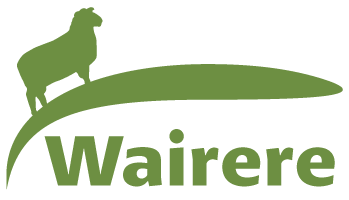
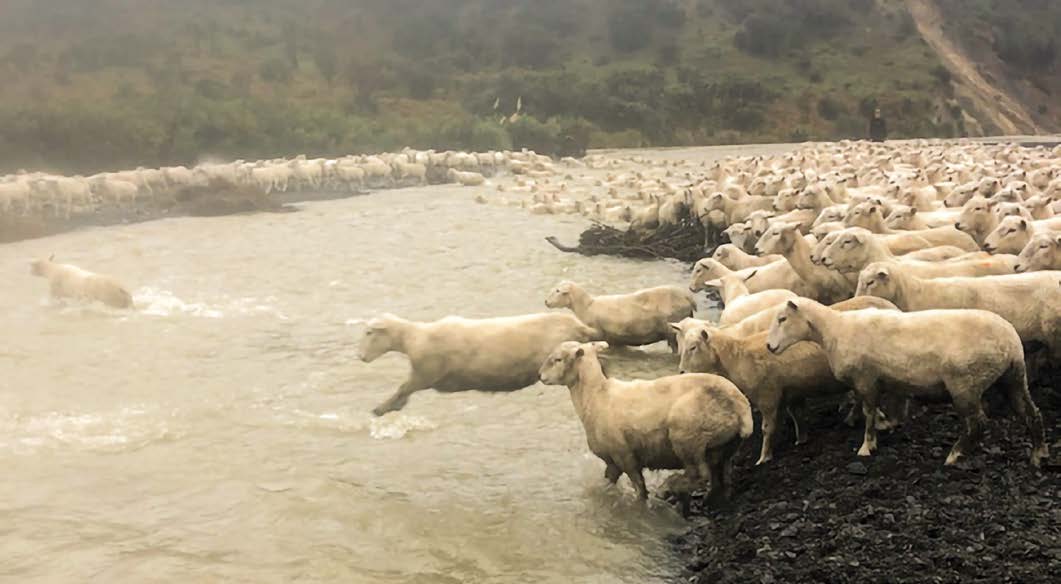
Hi There wow blown away by the truths i have read.Sink or swim fell out of my farm paper when i got to read it after a hard days slogging up and down hills in my trusty fletcher yes 40+ yrs in the cockpit you have hit the bloody nail on the head great stuff only problem as discuss with my 93 yr old mum from a farming back ground is it will not get to the citys Have been to the polls hoping its right or we will sink ! Regards John Spence.
Boy do I miss my old mate Rob Muldoon he helped me get a proper apprenticeship that my parents didn’t have to bank roll and now, after you have been to polytechnic for a year you have to find someone to take you on to complete the onsite assignments which you can’t find so you never get the apprenticeship completed but spent all the money with polytechnic. Waikato in one class 32 students paying approximately $10,000.00 a year 2 boys got full time apprenticeships? And they say we have no tradesmen! Need a real government, bring back Rob.
Yes I worked on those think big schemes at the time I thought they had great value and still do for New Zealand, electrifying the main trunk line how much has that saved over the years? and carbon, I think that maybe an accident.
Along comes Lange and Rodger Douglas with their great ideas sold them all off and 25 years on New Zealand is a much poorer country. I really do miss the 1970’s.